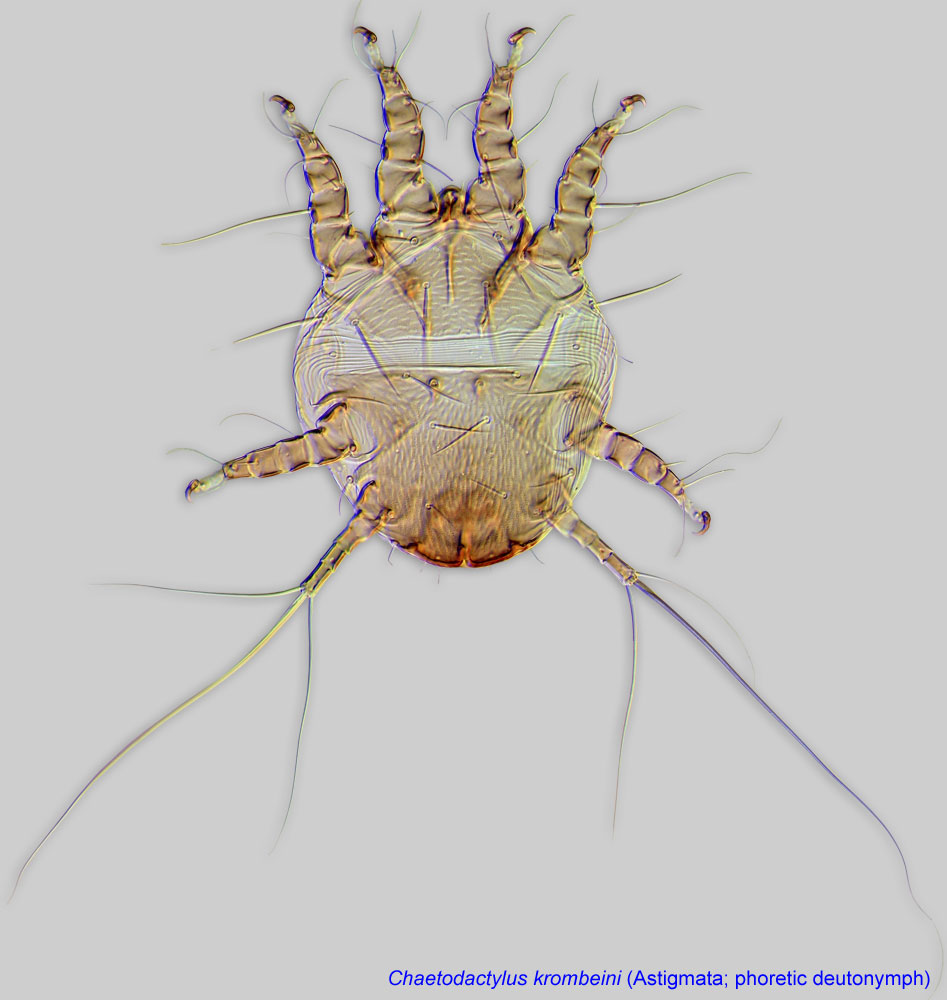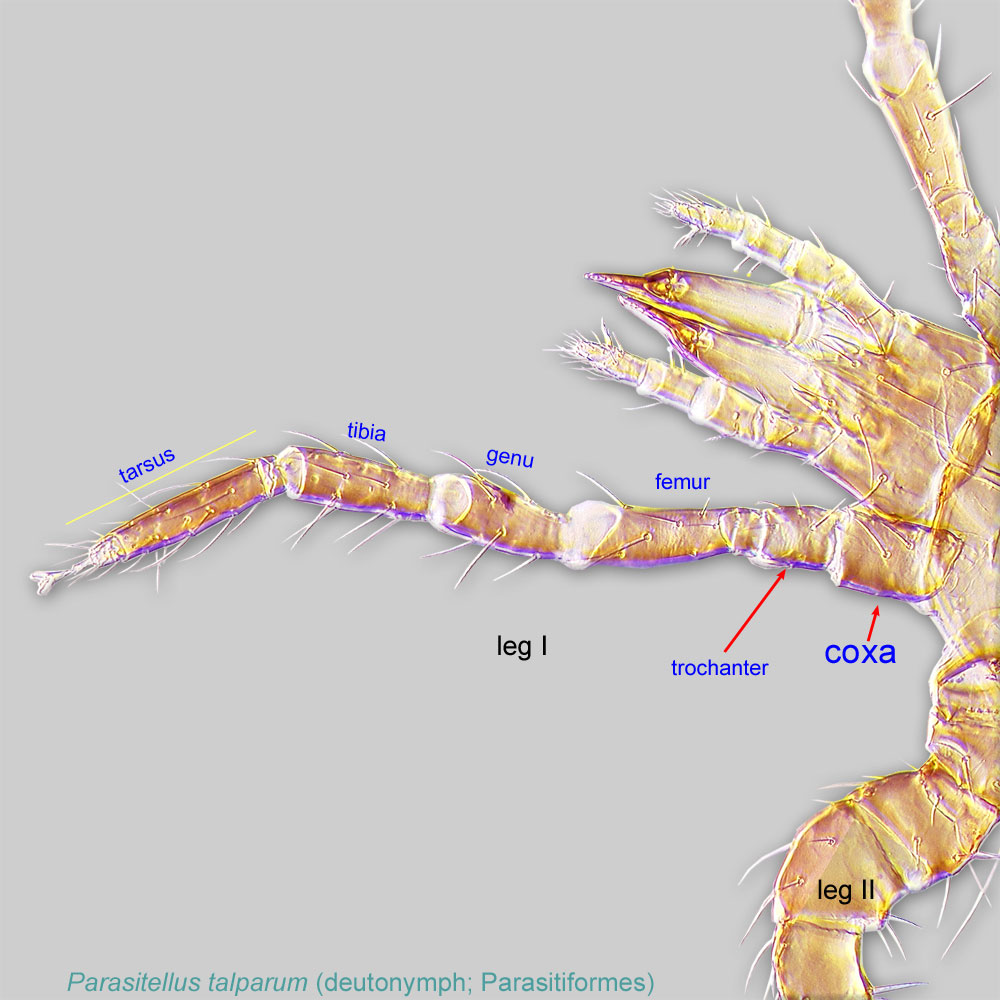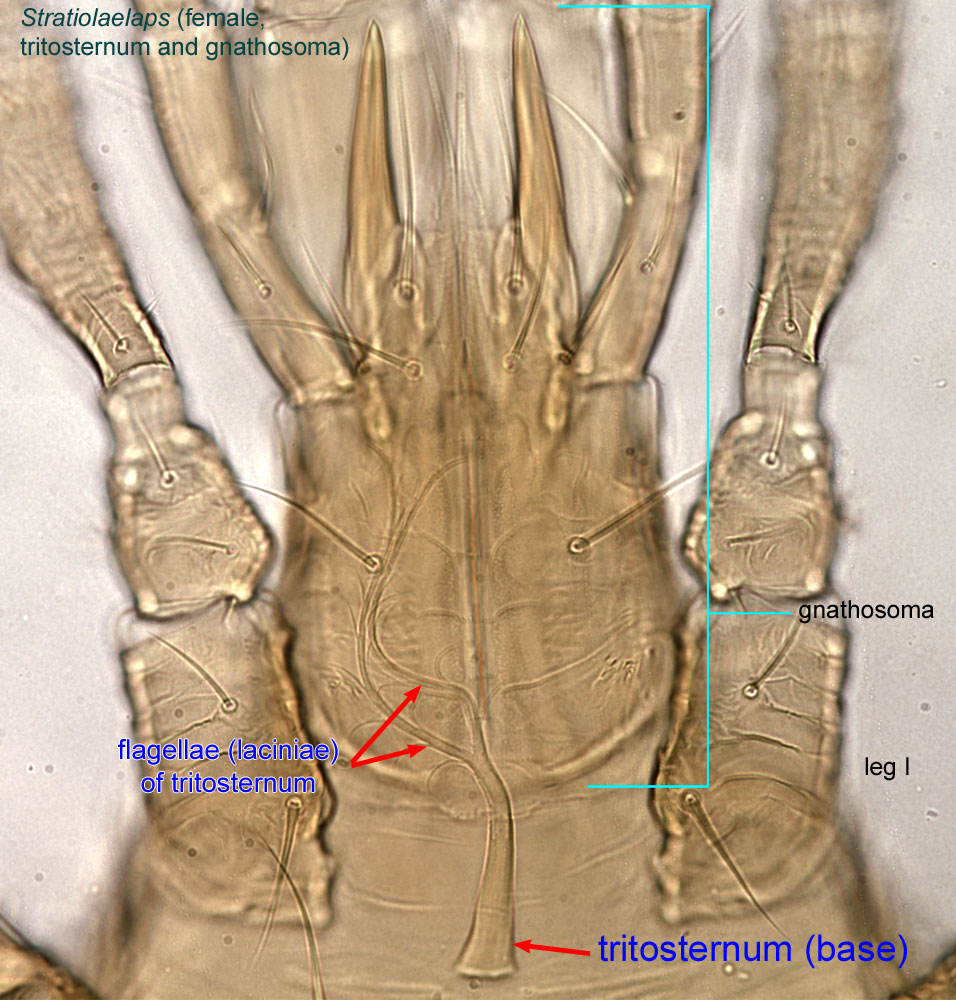considered neutral to beneficial; most species feed on nematodes and other small invertebrates
Infraorder Uropodina
Superorder Parasitiformes » Order Mesostigmata » Suborder Monogynaspida » Infraorder Uropodina
Deutonymph deutonymph:
Ontogenetic stage between protonymph and tritonymph (or adult, if tritonymph is absent). See <a href="index.cfm?pageID=1720">Life stages page</a> for more details. and Adult: CoxaeCoxa:
and Adult: CoxaeCoxa:
In Parasitiformes, most basal leg segment (or podomere) forming a joint with the body. Areas delimited by coxal apodemes are called coxal fields in Astigmata or coxisternal plates in Prostigmata.
 I greatly enlarged, partially or entirely covering base of tritosternumtritosternum:
I greatly enlarged, partially or entirely covering base of tritosternumtritosternum:
In Mesostigmata, a biflagellate structure situated on the ventral side of the body, posterior to the gnathosoma and anterior to the sternal shield. Sometimes the flagellae (laciniae) are partially or completely fused.  (Figs. 2, 3). Stigmata situated between legs II and III (Fig. 2).
(Figs. 2, 3). Stigmata situated between legs II and III (Fig. 2).
Genera should be identified using a key in Hirschmann, 1993Hirschmann, 1993:
Hirschmann, W. 1993. Gangsystematik der Parasitiformes. Teil 550. Bestimmungstabellen der Uropodiden der Erde. Atlas der Ganggattungen der Atrichopygidiina. Acarologie, Schriftenreihe für vergleichende Milbenkunde 40: 292-370., with updates from Halliday, 2015Halliday, 2015:
Halliday, R. B. 2015. Catalogue of genera and their type species in the mite Suborder Uropodina (Acari: Mesostigmata). Zootaxa 3972: 101-147.. Species should be identified using references summarized in Wiśniewski and Hirschmann, 1993Hirschmann, 1993:
Hirschmann, W. 1993. Gangsystematik der Parasitiformes. Teil 550. Bestimmungstabellen der Uropodiden der Erde. Atlas der Ganggattungen der Atrichopygidiina. Acarologie, Schriftenreihe für vergleichende Milbenkunde 40: 292-370.. Regional keys to species are available for Central Europe (Karg, 1989Karg, 1989:
Karg, W. 1989. Acari (Acari), Milben-Unterordnung Parasitiformes (Anactinochaeta). Uropodina Kramer, Schildkrotenmilben. Tierwelt Deutschlands 67: 1-203.) and the former USSR (Kadite and Petrova, 1977Kadite and Petrova, 1977:
Kadite, B. A. amp; A. D. Petrova. 1977. [Cohort Uropodina, fam. Uropodidae]. In [Opredelitel' obytayshchikh v pochve kleshchey Mesostigmata = Identification key to soil-inhabiting mites Mesostigmata], eds. M. S. Gilarov amp; N. G. Bregetova, 632-690. Leningrad: Nauka.).
The following families and genera of the infraorder Uropodina are known from bees or their nests: Trachytidae (Uroseius), Trematuridae (Trematura, Trichouropoda, Trichosociata, and Pseuduropoda), Uroactiniidae (Uroactinia), Urodinychidae (Uroobovella, Uroobovella (Fuscouropoda)), and Uropodidae (Uropoda).
The systematics of this group is poorly developed and very complicated (Halliday, 2015Halliday, 2015:
Halliday, R. B. 2015. Catalogue of genera and their type species in the mite Suborder Uropodina (Acari: Mesostigmata). Zootaxa 3972: 101-147.). For this reason we do not treat this group further in this tool and advise users consult a specialist for specimen identification.
Cosmopolitan. Mites associated with bees have been found in the Neotropical, Palaearctic, Oriental, and Australian regions.
honey bees (Apis), bumble bees (Bombus), orchid bees (Euglossa), and stingless bees of the genus Melipona
facultative facultative:
can complete entire life cycle without bees or their close relative, wasps
for majority of species associated with bees; unknown for species associated with euglossine bees
 are phoreticphoretic:
are phoreticphoretic:Mites belonging to the infraorder Uropodina are very common and abundant in forest litter, dung and carrion, decaying plant materials, stored food, moss, and under stones, in ant and bee nests, and in vertebrate nests and burrows. Most species are probably generalist predators feeding on nematodes or other small invertebrates, but others may feed on living and dead fungi and plant tissue (Lindquist et al., 2009Lindquist et al., 2009:
Lindquist, E. E., G. W. Krantz amp; D. E. Walter. 2009. Order Mesostigmata. In A Manual of Acarology. Third Edition., eds. G. W. Krantz amp; D. E. Walter, 233-420. Lubbock, Texas: Texas Tech University Press.). Phoreticphoretic:
Pertaining to phoresy; using another organism (i.e., a host) for dispersal to new habitats. Phoresy can be distinguished from parasitism because feeding typically does not occur during phoresy.
deutonymphsdeutonymph:
Ontogenetic stage between protonymph and tritonymph (or adult, if tritonymph is absent). See <a href="index.cfm?pageID=1720">Life stages page</a> for more details. in this group have been collected on bees and all stages collected in nests. Nothing is known about their biology, but the majority of Uropodina species are not parasitic (except for some ant associates). Thus, the group is generally considered to be harmless. Some species regularly occur on euglossine bees (Fig. 5) and may develop specialization for their bee hosts.
in this group have been collected on bees and all stages collected in nests. Nothing is known about their biology, but the majority of Uropodina species are not parasitic (except for some ant associates). Thus, the group is generally considered to be harmless. Some species regularly occur on euglossine bees (Fig. 5) and may develop specialization for their bee hosts.